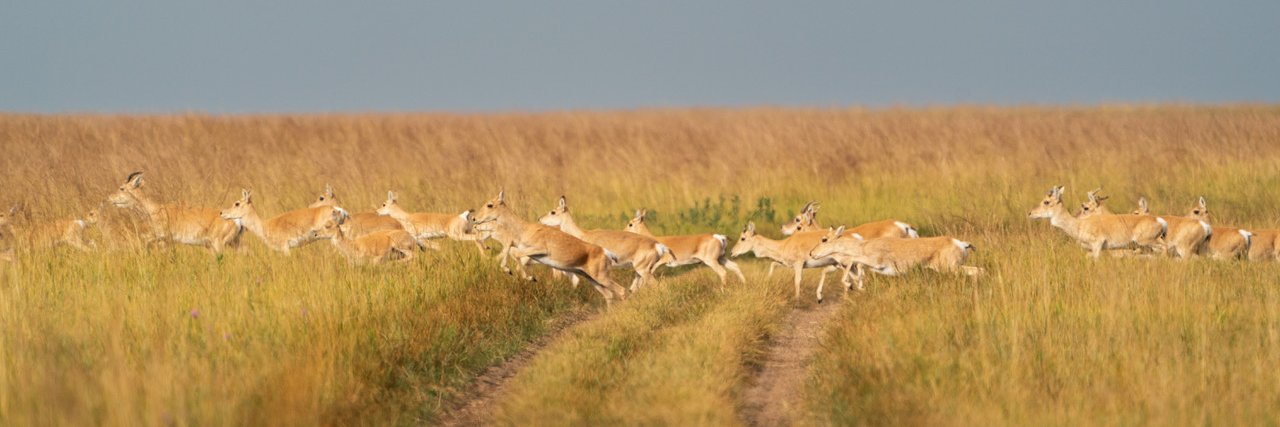
Global Initiative on Ungulate Migration
@migratinghooves
Advancing the conservation of the world’s migratory ungulates by mapping migrations, compiling a global atlas, and conducting collaborative research.
🚨 BIG NEWS! GLOBAL INITIATIVE ON UNGULATE MIGRATION PUBLISHED IN SCIENCE youtube.com/watch?v=8_Np6A…
We presented at the #ECM9 last week - @SteffenMumme, Francesca Cagnacci and Melinda Boyers spoke on our recent work quantifying the overlap of migration corridors with protected areas, mapping the white-eared kob in South Sudan, & conserving corridors in fragmented landscapes!



New postdoc opportunity projecting the effects of climate change on the summer behavior and distributions of caribou in the Arctic. Apply here (job title: "Post Doctoral Fellow - Future of Species Range Shifts"): shorturl.at/X8CSl. Photo by Joëlle Taillon.

Investigative journalism into South Africa and South Sudan's plans to drill in lands traversed by the Great Nile Migration -- read here and see how our maps were used to support this story! @dailymaverick shorturl.at/NFkcX

Animals have culture too and it could change the way we protect them! Animal culture includes socially learned behaviours that groups pass down through generations. 🐋 @royalsociety's Philosophical Transactions B journal has just launched the first-ever themed issue on this…
The tiang migration in South Sudan is one of our newest migration maps in the Atlas! As their landscape faces demographic shifts, energy extraction and infrastructure development, corridor maps are a tool for land managers in the region! 📸 Marcus Westburg


🚨 Just launched: new @migratinghooves maps of the Great Nile Migration, the biggest land-animal trek on Earth! Over 5 million white-eared kob + 400K tiang roam 100,000 km² between South Sudan & Ethiopia. 🐾 View the maps and discover how they can steer wildlife-friendly…
We are excited to announce the newest maps in the Atlas of Ungulate Migration: the white-eared kob and tiang in South Sudan and Ethiopia! These maps will serve as tools in balancing the needs of both people and wildlife in this incredible region. shorturl.at/fFc4M
"The one thing they need to survive en masse is freedom of movement over large landscapes." A new study finds that the caribou's collective memory of bad winter conditions is driving a major migratory range shift in the Western Arctic herd. Read more: biographic.com/what-the-carib…

We are excited to present at the 9th European Congress of Mammalogy in #Patras this week! Come talk migration science and #conservation with us there @MammalConsEur @EuroMammals @HellenicZoolSoc

Research opportunity: open PhD position researching the movement ecology of Svalbard reindeer and the impacts of climate change on their population and distribution! jobbnorge.no/en/available-j… @UNISvalbard
Join us on March 26 at 4pm GMT / 12pm EDT for Variety Hour! Connect with the projects, research, and ideas happening in #conservationtech, like: ungulate migration, annotation workflows, repurposing sensors, and detecting projectiles. Register here: wildlabs.net/event/variety-…
From discovering “secret calving grounds” by following animals in the snow to the advent of GPS tracking tech, the scientists studying Tibetan antelope migrations are still learning about where and why these mysterious animals move. Read here! @WenjingXu8 shorturl.at/kuMJz
We're excited to begin sharing some longer form stories about the people, science and conservation efforts behind the wild migrations we map in the Atlas. Follow us on @Medium for stories like this one about the recovery of saiga antelope in Kazakhstan! tinyurl.com/vhmv36dt

Migratory species are impacted by #ClimateChange, affecting their role in sustaining ecosystems that benefit us.🐘 Our report reveals changes in migration patterns & challenges in breeding. Migratory species are vital for climate resilience! 🌏 Download:cms.int/en/publication…
Excited to see our Atlas of Ungulate Migration highlighted at the @UNBiodiversity #cop16cali! Enhancing ecological connectivity and using the power of animal tracking data to inform #conservation are key applications of our work (thanks @WILDLABSNET & @Largelandscapes )



.@AltynDala wins The Earthshot Prize to Protect and Restore Nature for its epic work bringing endangered species back from the brink of extinction. Next step: restore a fully flourishing Steppe in Kazakhstan! #EarthshotCapeTown
If you are at @UNBiodiversity #COP16Colombia, GIUM is co-organizing two sessions on the power of animal tracking data and conservation with @SmithsonianMoL and @WILDLABSNET Oct. 29th and 30th! See details here: shorturl.at/NbqMf
Pastoral activities are often viewed as a threat to #conservation, especially in migratory landscapes, but check out this paper by GIUM colleague @WenjingXu8 on how we can better balance the needs of herders, wildlife and livestock in shared spaces. pnas.org/doi/10.1073/pn…
Being named an @EarthshotPrize finalist is so well deserved for @AltynDala... the kind of data they've collected on saiga migrations is important not only for Kazakhstan but for showing the impacts of linear infrastructure on migratory animals around the world! Good luck!
Huge congrats to 2023 #WhitleyAwards winner, Albert Salemgareyev, & the @AltynDala for being @EarthshotPrize finalists!🌿🌍Their work restoring the #Kazakhsteppes & protecting the iconic #saigaantelope is a global #successstory of #optimism and action!💚 #ConservationInnovation
See @WWF on the Atlas & value of long-term tracking: "Comparing zebra's movements over multiple years will strengthen our knowledge of where, when & how zebras migrate, and help us better protect important wildlife corridors and landscape #connectivity." shorturl.at/8CoBd